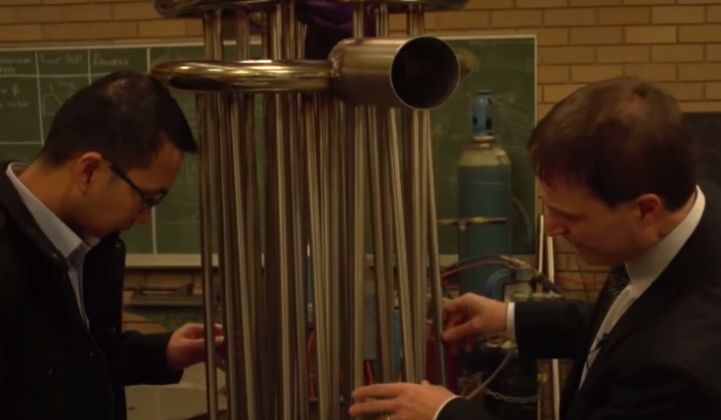An Australian team is hoping to boost the efficiency of solar-powered refrigeration processes by storing excess energy in salt-based phase-change materials.
“Relative to storing solar PV in a battery, which is then used to run the refrigeration system, the overall efficiency is more than 90 percent,” said Dr. Martin Belusko, senior research fellow at the Barbara Hardy Institute, University of South Australia, and a member of the team.
The technology has drawn attention after winning one of the Australian Museum’s annual Eureka Prizes for excellence in research and innovation.
“The potential this technology offers for renewable energy to form a much larger slice of Australia’s electricity generation through low-cost energy storage is very exciting,” said Kim McKay, executive director and CEO of the Australian Museum, in a press release.
The concept is being commercialized by a company called Glaciem Cooling Technologies, formerly trading as Quik-Cool, which has assembled a pilot plant with a storage capacity equivalent to 1.1 megawatt-hours and is courting prospective clients in the dairy industry.
“Thermal storage in the form of ice bank/slurry has been used successfully in air conditioning applications for many years,” says the company on its website. “However, its use in medium- to low-temperature refrigeration applications is limited, as the temperature requires a phase change to be significantly lower than the melting point of ice.”
The system developed by the University of South Australia team can use excess solar energy to freeze a salt solution that provides cooling when PV power is no longer available. The phase-change material (PCM) is contained in coils within a purpose-built tank.
It melts at a temperature below zero degrees Celsius, so that “sub-zero secondary refrigerant glycol temperatures of minus 6 degrees Celsius and below are possible, which in turn gives process/cool-room temperatures as low as minus 3 degrees Celsius,” according to Glaciem’s website.
“As in a battery setup, storing the energy will only be done if there is a lack of demand for the solar electricity,” Belusko explained. “During times when there is a refrigeration load, the solar PV will drive the refrigeration system. The aim is not to displace electric storage, but complement" it.
Controlling the power demand of inverter-driven refrigeration systems is relatively straightforward, he noted. “This demand can be matched to the solar PV output. Any excess refrigeration load can then be met by the PCM storage system.”
As well as refrigeration, the research team sees potential for the PCM system in commercial air conditioning and industrial heat processes in the chemical and food processing industries. Such systems might be charged from the grid when wholesale prices are low, Belusko theorized. South Australia currently gets more than 35 percent of its electricity from renewable sources, which forces wholesale prices into negative figures on occasions.
“For many large commercial facilities, the use of solar PV in Australia can be commercially attractive,” Belusko said. “However, due to various changes in tariff structures, solar PV can now only be of value through on-site consumption. This is where energy storage is critical.”
The research team is now working on developing similar PCM storage systems for other thermal applications, including residential hot water and air conditioning, as well as high-temperature storage and concentrating solar power.
That might be a challenge. While PCM has long been seen as a potential route to low-cost energy storage for grid-scale solar thermal plants, no developer has yet stepped forward to try out the technology in earnest.
A U.S. company called Terrafore Technologies, for example, claims to have a system that could cut solar thermal energy storage costs by 40 percent, but has yet to find customers that will help take the technology to commercialization.
The problem, ironically, is that the concentrating solar power industry already uses salt for storage, but in a different way. Converting the current molten salt technology to PCM would be a risky undertaking for a sector that does not have spare cash for experimentation.
Maybe some rooftop solar-storage setups in Australia could change that perception, though.



